

High-Fat Ketogenic Diets and Physical Performance: A Systematic Review. Processing math: 100% Skip to Main Content Advertisement.
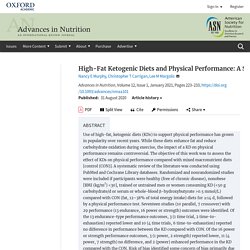
Non-carbohydrate Dietary Factors and Their Influence on Post-Exercise Glycogen Storage: a Review. What Should I Eat before Exercise? Pre-Exercise Nutrition and the Response to Endurance Exercise: Current Prospective and Future Directions. One of the reasons athletes perform training sessions in the fasted state is a desire to increase fat oxidation during exercise [15].
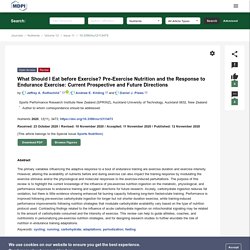
As discussed above (Section 2.1), fat oxidation is higher during an acute bout of exercise performed in the overnight-fasted, compared with the CHO-fed state, and with low compared with high muscle glycogen. Despite these differences, most studies have found no differences in fat oxidation following 4–6 weeks of fed or fasted-state training when tested in the fed [13,14,145] or fasted [31,146] state.
Nutritional Considerations and Strategies to Facilitate Injury Recovery and Rehabilitation. Primary, Secondary, and Tertiary Effects of Carbohydrate Ingestion During Exercise. 1.Bergstrom J, et al.
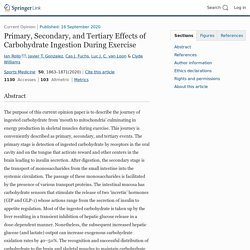
Diet, muscle glycogen and physical performance. Acta Physiol Scand. 1967;71(2):140–50.CAS PubMed Google Scholar 2.Sherman WM, et al. Effect of exercise-diet manipulation on muscle glycogen and its subsequent utilization during performance. Int J Sports Med. 1981;2(2):114–8.CAS PubMed Google Scholar 3.Brewer J, Williams C, Patton A. Supplements and Nutritional Interventions to Augment High-Intensity Interval Training Physiological and Performance Adaptations—A Narrative Review. 1.

Introduction High-intensity interval training (HIIT) involves repeated bursts of vigorous intense exercise (lasting a few seconds up to several minutes) separated by passive rest or low-intensity exercise [1]. HIIT is a viable and time-efficient alternative to induce physiological and cardiorespiratory adaptations [2,3,4]. The specific physiological adaptations induced by HIIT are likely determined by several parameters including intensity, duration, number of intervals performed, the duration and activity during recovery, mode of exercise [5,6], and potentially diet.
In untrained and recreationally active individuals, short term (~2 weeks) HIIT is a potent stimulus to induce cardiorespiratory and physiological alterations similar to traditional endurance training, despite lower total exercise volume and training time commitment [7]. In an athletic population, HIIT is an essential training component to maximize performance and has been used for decades [5].
Table 1. 2. 3. 4. 5. 6. פעילות גופנית וספורט בילדים ובני נוער. Dietary Fuels in Athletic Performance. Athletes undertake an exceptional amount of training, which is why focusing on their daily diet is of great importance.
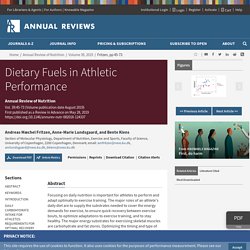
The major roles of an athlete's daily diet are to supply the nutrients needed to cover the energy demands of their training program, to optimize the adaptations achieved during and in response to training sessions, and to ensure quick recovery between workouts. Also, athletes must eat to stay in good health and avoid dietary practices that might compromise health. Evidence demonstrates that dietary macronutrient availability is essential for optimal performance and plays an important role in modulating skeletal muscle adaptations to endurance and resistance training. Nutrition and Supplement Update for the Endurance Athlete: Review and Recommendations. 3.1.
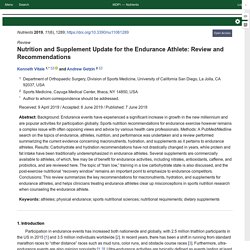
Carbohydrate Carbohydrate requirements for the endurance athlete can be a fiery topic, often leading to passionate (and sometimes confrontational) debates on ideal intake amongst the fitness and medical community. Sleep and Nutrition Interactions: Implications for Athletes. Sleep, in humans, is defined as a complex reversible behavioural state where an individual is perceptually disengaged from and unresponsive to their environment [1].
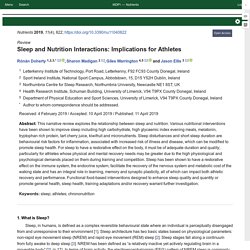
Sleep architecture has two basic states based on physiological parameters: non-rapid eye movement sleep (NREM) and rapid eye movement (REM) sleep [2]. Sleep stages fall along a continuum from fully awake to deep sleep [3]. NREM has been defined as “a relatively inactive yet actively regulating brain in a moveable body” [2], (p.17). In terms of brain activity, the electroencephalogram (EEG) pattern of NREM sleep is commonly described as synchronous (increasing depth of sleep is indicated by progressive dominance of high voltage, low frequency EEG patterns), with characteristic waveforms (sleep spindles, K-complexes and high voltage waves) [2].
NREM is usually associated with minimal or fragmented mental activity. Advances in Sport and Performance Nutrition. Performance Nutrition for Athletes. Dietary Practices Adopted by Track-and-Field Athletes: Gluten-Free, Low FODMAP, Vegetarian, and Fasting. Some track-and-field athletes implement special diets aiming to improve health and/or performance.
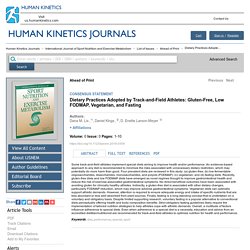
An evidence-based approach to any diet is recommended to minimize the risks associated with unnecessary dietary restriction, which may potentially do more harm than good. Four prevalent diets are reviewed in this study: (a) gluten-free; (b) low fermentable oligosaccharides, disaccharides, monosaccharides, and polyols (FODMAP); (c) vegetarian; and (d) fasting diets. Recently, gluten-free diets and low FODMAP diets have emerged as novel regimes thought to improve gastrointestinal health and reduce the risk of exercise-associated gastrointestinal symptoms. Nutrition in Ultra-Endurance: State of the Art. 1.
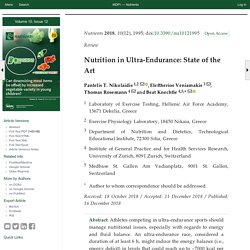
Introduction An ultra-endurance race may refer to running, cycling, swimming, cross-country skiing or a multi-sport event such as triathlon. The criterion to define these modes of exercise as ultra-endurance is to last at least six hours [1]. On the other side of the spectrum of duration, an ultra-endurance race may last even days or weeks.
In these races, athletes usually compete for time, i.e., they attempt covering a given distance in the least time; however, other formats of races exist too, e.g., they might compete for distance where they aim to cover a maximum distance for a given time (e.g., 12 h run). A major nutritional concern is the high energetic demands accompanying the physiological stress of exercise. In general, ultra-endurance athletes adopt nutritional strategies similar to endurance athletes; nevertheless, they might present unique nutrition-related characteristics. 3. It has been observed that the environmental conditions influence the occurrence of EAH. ISSN exercise & sports nutrition review update: research & recommendations.
Energy Availability, Macronutrient Intake, and Nutritional S... : Current Sports Medicine Reports. Endurance athletes use nutritional guidelines and supplements to improve exercise performance and recovery.
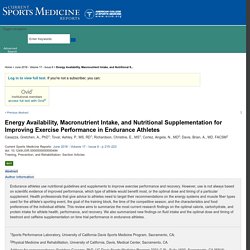
However, use is not always based on scientific evidence of improved performance, which type of athlete would benefit most, or the optimal dose and timing of a particular supplement. Health professionals that give advice to athletes need to target their recommendations on the energy systems and muscle fiber types used for the athlete’s sporting event, the goal of the training block, the time of the competitive season, and the characteristics and food preferences of the individual athlete.
This review aims to summarize the most current research findings on the optimal calorie, carbohydrate, and protein intake for athlete health, performance, and recovery. 2013 Sport nutrition: A review of the latest guidelines for exercise and sport nutrition. Sport nutrition: A review of the latest guidelines for exercise and sport nutrition from the American College of Sport Nutrition, the International Olympic Committee and the International Society for Sports Nutrition Abstract Evidence-based sport nutrition guidelines which explore the connection between nutrition, exercise and well-being form a crucial part of any athlete’s competitive and training programme.
Guidelines that are based on sound scientific evidence about the quantity, structure and timing of food intake are important to ensure that athletes train more effectively to reduce the risk of injury and illness. Appropriate nutrition complements training and recovery and can induce metabolic adaptations to training. Adequate energy should derive from a variety of foods that provide carbohydrates, proteins, fat and micronutrients. 2014 FINA-Yakult Consensus Statement on Nutrition for the Aquatic Sports. Home » FINA-Yakult Consensus Statement on Nutrition for the Aquatic Sports FINA-Yakult Consensus Statement on Nutrition for the Aquatic Sports Detopoulou, Paraskevi; Papamikos. 2016 Nutrition and the Endurance Runner. March 2016 Issue Nutrition and the Endurance Runner By Andrea N. Giancoli, MPH, RD Today's Dietitian Vol. 18 No. 3 P. 28. Nutrients 2016 Special Issue : Nutrition, Health and Athletic Performance.
Gastrointestinal (GI) ischemia during exercise is associated with luminal permeability and increased systemic lipopolysaccharides (LPS). This study aimed to assess the impact of a multistrain pro/prebiotic/antioxidant intervention on endotoxin unit levels and GI permeability in recreational athletes. Thirty healthy participants (25 males, 5 females) were randomly assigned either a multistrain pro/prebiotic/antioxidant (LAB4ANTI; 30 billion CFU·day−1 containing 10 billion CFU·day−1Lactobacillus acidophilus CUL-60 (NCIMB 30157), 10 billion CFU·day−1Lactobacillus acidophillus CUL-21 (NCIMB 30156), 9.5 billion CFU·day−1Bifidobacterium bifidum CUL-20 (NCIMB 30172) and 0.5 billion CFU·day−1Bifidobacterium animalis subspecies lactis CUL-34 (NCIMB 30153)/55.8 mg·day−1 fructooligosaccharides/ 400 mg·day−1 α-lipoic acid, 600 mg·day−1N-acetyl-carnitine); matched pro/prebiotic (LAB4) or placebo (PL) for 12 weeks preceding a long-distance triathlon.
2016 Basic Principles of Sports Nutrition. 2016 Nutritional implications for ultra-endurance walking and running events. Energy needs of the ultramarathon athlete As can be seen in Table 1, ultra-endurance events are highly diverse, but available literature suggest that they result in an energy deficit. 2016 Nutrition and Athletic Performance. International society of sports nutrition position stand: diets and body composition. Low-energy diets Low-energy diets (LED) and very-low-energy diets (VLED) are characterized by their provision of 800–1200 kcal/day and 400–800 kcal/day, respectively [21]. Note that LED have also been given a more liberal definition of providing 800–1800 kcal [22]. Very-low-energy diets are typically in liquid form and commercially prepared. The aim of the diet is to induce rapid weight loss (1.0–2.5 kg/week) while preserving as much LM as possible.
VLED are designed to replace all regular food consumption, and therefore should not be confused with meal replacement products intended to replace one or two meals per day. Resistance training has shown an impressive ability to augment the preservation of muscle and even increase it during VLED – at least in untrained/obese subjects. In obese populations, aggressive caloric restriction is a potentially powerful intervention since a greater initial weight loss is associated with greater long-term success in weight loss maintenance [27]. Promotion of Healthy Weight-Control Practices in Young Athletes. International society of sports nutrition position stand: nutrient timing. The International Society of Sports Nutrition (ISSN) published the first position stand devoted to the practice of nutrient timing in 2008 [1].
Consequently, this paper has been accessed approximately 122,000 times. In the past nine years, multiple lines of research have explored questions directly related to the timing of nutrients that further refines information about evidence-based nutritional recommendations. Nutrient timing involves the purposeful ingestion of all types of nutrients at various times throughout the day to favorably impact the adaptive response to acute and chronic exercise (i.e., muscle strength and power, body composition, substrate utilization, and physical performance, etc.).
Importantly, much of the interest and available research centers upon outcomes related to those who are regularly competing in some form of aerobic or anaerobic exercise; however, nutrient timing strategies may offer favorable outcomes for non-athletic and clinical populations. Practical nutritional recovery strategies for elite soccer players when limited time separates repeated matches. Selected In-Season Nutritional Strategies to Enhance Recovery for Team Sport Athletes: A Practical Overview.